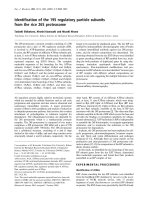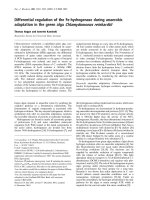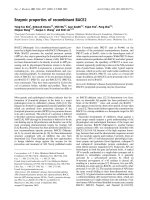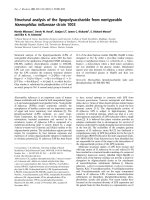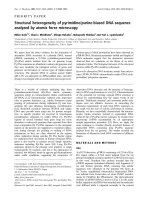Báo cáo y học: "Anticoagulant properties of drotrecogin alfa (activated) during hemofiltration in patients with severe sepsis" potx
Bạn đang xem bản rút gọn của tài liệu. Xem và tải ngay bản đầy đủ của tài liệu tại đây (40.89 KB, 2 trang )
Available online />Page 1 of 2
(page number not for citation purposes)
Abstract
In a retrospective study among 35 severely septic patients treated
with drotrecogin alfa (activated) (DrotAA) and renal replacement
therapy (RRT), Camporota and colleagues demonstrated that the
addition of heparin, epoprostenol, or both to DrotAA during RRT
did not improve filter survival. Furthermore, in a multivariate logistic
regression analysis, they identified the minimum value in platelet
count as the only predictive factor of filter clotting during DrotAA
infusion. These findings are in line with the previously formulated
suggestion that DrotAA alone is as effective as heparin in the
prevention of coagulation in the extracorporeal circuit. They also
confirm the importance of baseline platelet count in the patho-
genesis of extracorporeal circuit thrombosis. In the study by
Camporata and colleagues, DrotAA treatment was not associated
with an increase in red blood cell requirements. The results of this
study supply a background to clinical decision making when
choosing an anticoagulant for RRT in septic patients.
In the last 2008 issue of Critical Care, Camporota and
colleagues [1] reported the results of a retrospective study
analyzing filter survival time and transfusion requirements
among 35 severely septic patients treated with drotrecogin
alfa (activated) (DrotAA) and renal replacement therapy (RRT).
DrotAA is capable of reducing mortality in severely septic
patients [2] and the international guidelines for management
of severe sepsis and septic shock recommend considering
its use in adult patients with sepsis-induced organ dys-
function and high risk of death [3]. Among septic patients,
acute renal failure (ARF) is common: its incidence ranges
from 19% in moderate sepsis to 51% in septic shock [4].
ARF patients have an increased risk of mortality and this risk
is even higher among patients treated with RRT [5]. As the
annual incidence of sepsis ranges from 100 to 300 per
100,000 inhabitants and 30% to 40% of septic patients
develop severe sepsis [6], the number of patients meeting
the indications for treatment with both DrotAA and RRT is
considerable.
As DrotAA is an anticoagulant itself, the risk of bleeding
during its use might be increased by the addition of other
anticoagulants during RRT. Until now, only one report of three
cases has been published on this topic. This report
suggested that Drot AA alone is as effective as heparin in the
prevention of coagulation in the extracorporeal circuit [7].
The current study demonstrates that the addition of heparin,
epoprostenol, or both to DrotAA during RRT does not
prolong filter survival. The lack of an additional effect of
heparin on filter survival is not surprising since the anti-
thrombotic effect of DrotAA is not enhanced by the addition
of heparin [8]. However, since epoprostenol is a potent
inhibitor of platelet function and DrotAA does not seem to
have a direct inhibitory effect on platelet aggregation [9], one
might have expected prolongation of filter survival during
treatment with both DrotAA and epoprostenol.
Notably, multivariate logistic regression analysis identified the
minimum value in platelet count as the only predictive factor
of filter clotting during DrotAA infusion. Several studies have
demonstrated the association between baseline platelet
count and circuit clotting, especially during postdilution
[10,11]. It is hypothesized that, due to an increase in local
viscosity and shear stress, a higher baseline platelet count
facilitates platelet cohesion along the hollow fiber wall [11].
Increased platelet cohesion may cause enhanced thrombin
generation in the hemofilter, leading to filter clotting. During
sepsis, however, coagulation is initiated by inflammatory
mediators, such as endotoxin and cytokines, capable of
inducing tissue factor expression on monocytes and macro-
phages [12]. DrotAA can completely inhibit tissue factor-
induced platelet activation [13]. Since epoprostenol inhibits
platelet function by increasing the synthesis of cyclic
adenosine monophosphate, its effect may be insufficient to
Commentary
Anticoagulant properties of drotrecogin alfa (activated) during
hemofiltration in patients with severe sepsis
Anne CJM de Pont and Marcus J Schultz
Department of Intensive Care Medicine, Academic Medical Center, University of Amsterdam, Meibergdreef 9, 1105 AZ Amsterdam, The Netherlands
Corresponding author: Anne CJM de Pont,
Published: 2 February 2009 Critical Care 2009, 13:113 (doi:10.1186/cc7684)
This article is online at />© 2009 BioMed Central Ltd
See related research by Camporota et al., />ARF = acute renal failure; DrotAA = drotrecogin alfa (activated); RRT = renal replacement therapy.
Critical Care Vol 13 No 1 de Pont and Schultz
Page 2 of 2
(page number not for citation purposes)
add to the effect of coagulation-induced platelet consumption
in combination with complete inhibition of tissue factor-
induced platelet activation by DrotAA.
In the current study, no difference in red blood cell require-
ments, either between DrotAA episodes and post-DrotAA
episodes or between medical and surgical patients, was
found. This is surprising given that, among the 4,459 patients
included in INDEPTH (International Integrated Database for
the Evaluation of Severe Sepsis and Drotrecogin alfa
[activated] Therapy), the bleeding incidence in surgical
patients was about 10 times higher in the DrotAA group than
in the placebo group (4.9% versus 0.5%) and in medical
patients it was about 2.5 times higher (2.6% versus 1%) [14].
The lack of a difference in the current study might be due to
the relatively small number of patients.
Conclusion
In summary, the results of the current study add to the
understanding of the effect of Drot AA on coagulation in the
extracorporeal circuit and supply a background to clinical
decision making when choosing an anticoagulant for RRT in
septic patients.
Competing interests
The authors declare that they have no competing interests.
References
1. Camporota L, Corno E, Menaldo E, Smith H, Lei K, Beale R,
Wyncoll D: Filter survival and blood products requirement in
patients with severe sepsis receiving drotrecogin alfa (acti-
vated) and requiring renal replacement therapy. Crit Care
2008, 12:R163.
2. Bernard GR, Vincent JL, Laterre PF, LaRosa SP, Dhainaut JF,
Lopes-Rodriguez A, Steingrub JS, Garber GE, Helterbrand JD, Ely
EW, Fisher CJ Jr. for the Recombinant Human Activated Protein C
Worldwide Evaluation in Severe Sepsis (PROWESS) study
group: Efficacy and safety of recombinant human activated
protein C for severe sepsis. N Engl J Med 2001, 344:699-709.
3. Dellinger RP, Levy MM, Carlet JM, Bion J, Parker MM, Jaeschke R,
Reinhart K, Angus DC, Brun-Buisson C, Beale R, Calandra T,
Dhainaut JF, Gerlach H, Harvey M, Marini JJ, Marshall J, Ranieri M,
Ramsay G, Sevransky J, Thompson T, Townsend S, Vender JS,
Zimmerman JL, Vincent JL for the International Surviving Sepsis
Campaign Guidelines Committee: Surviving Sepsis Campaign:
international guidelines for management of severe sepsis and
septic shock: 2008. Crit Care Med 2008, 36:296-327.
4. Schrier RW, Wang W: Acute renal failure and sepsis. N Engl J
Med 2004, 351:159-169.
5. Payen D, de Pont AC, Sakr Y, Spies C, Reinhart K, Vincent JL for
the Sepsis Occurrence in Acutely Ill Patients (SOAP) Investiga-
tors: A positive fluid balance is associated with a worse
outcome in patients with acute renal failure. Crit Care 2008,
12:R74.
6. Esteban A, Frutos-Vivar F, Ferguson ND, Peñuelas O, Lorente JA,
Gordo F, Honrubia T, Algora A, Bustos A, García G, Diaz-
Regañón IR, Ruiz de Luna R: Sepsis incidence and outcome:
contrasting the intensive care unit with the hospital ward. Crit
Care Med 2007, 35:1284-1289.
7. de Pont AC, Bouman CS, de Jonge E, Vroom MB, Büller HR, Levi
M: Treatment with recombinant human activated protein C
obviates additional anticoagulation during continuous ven-
ovenous hemofiltration in patients with severe sepsis. Inten-
sive Care Med 2003, 29:1205.
8. Levi M, Levy M, Williams MD, Douglas I, Artigas A, Antonelli M,
Wyncoll D, Janes J, Booth FV, Wang D, Sundin DP, Macias WL
for the Xigris and Prophylactic HepaRin Evaluation in Severe
Sepsis (XPRESS) Study Group: Prophylactic heparin in
patients with severe sepsis treated with drotrecogin alfa (acti-
vated). Am J Respir Crit Care Med 2007, 176:483-490.
9. Schuerholz T, Friedrich L, Marx G, Kornau I, Sümpelmann R,
Scheinichen D: Effect of drotrecogin alfa (activated) on platelet
receptor expression in vitro. Platelets 2007, 18:373-378.
10. de Pont AC, Oudemans-van Straaten HM, Roozendaal KJ, Zand-
stra DF: Nadroparin versus dalteparin anticoagulation in high-
volume, continuous venovenous hemofiltration: a
double-blind, randomized crossover study. Crit Care Med
2000, 28:421-425.
11. de Pont AC, Bouman CS, Bakhtiari K, Schaap MC, Nieuwland R,
Sturk A, Hutten BA, de Jonge E, Vroom MB, Meijers JC, Büller
HR: Predilution versus postdilution during continuous ven-
ovenous hemofiltration: a comparison of circuit thrombogen-
esis. ASAIO J 2006, 52:416-422.
12. Esmon CT: Crosstalk between inflammation and thrombosis.
Maturitas 2004, 47:305-314.
13. Kaiser B, Jeske W, Hoppensteadt DH, Walenga JM, Drohan W,
Fareed J:
In vitro studies on the effect of activated protein C on
platelet activation and thrombin generation. Thromb Res 1997,
87:197-204.
14. Payen D, Sablotzki A, Barie PS, Ramsay G, Lowry S, Williams
MD, Sarwat S, Northrup J, Toland P, Booth FV: International
integrated database for the evaluation of severe sepsis and
drotrecogin alfa (activated) therapy: analysis of efficacy and
safety data in a large surgical cohort. Surgery 2007, 141:548-
561.



